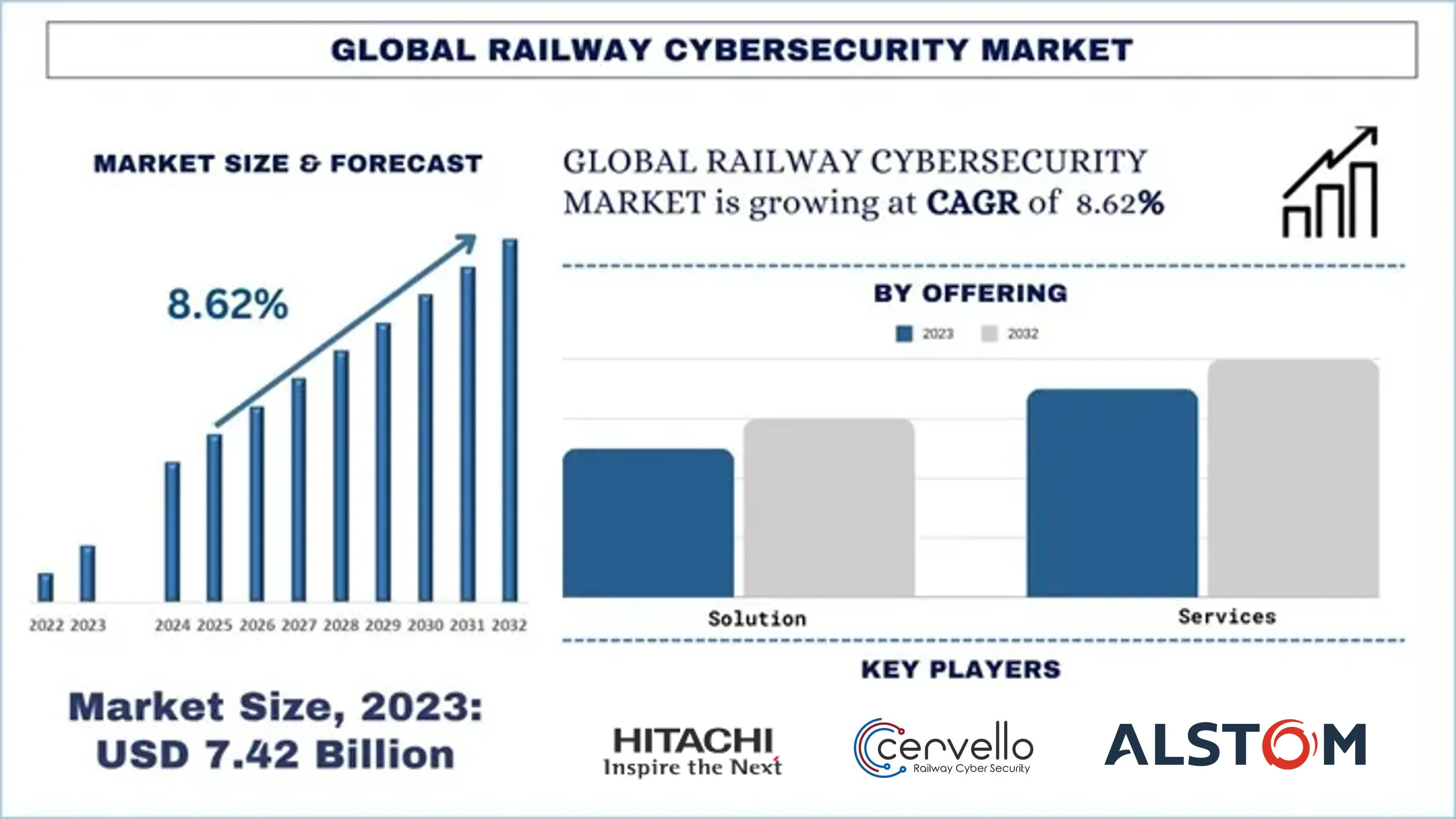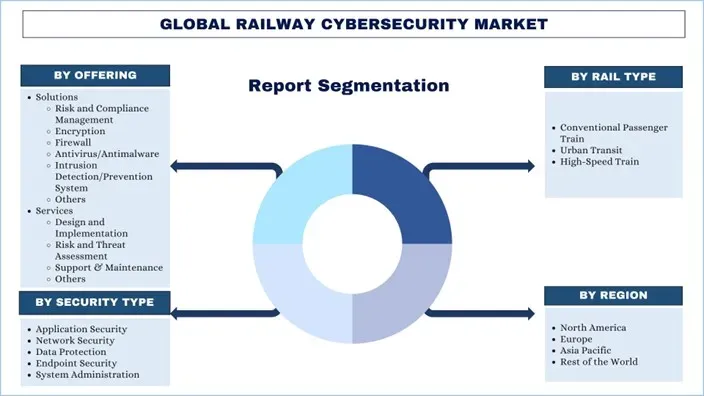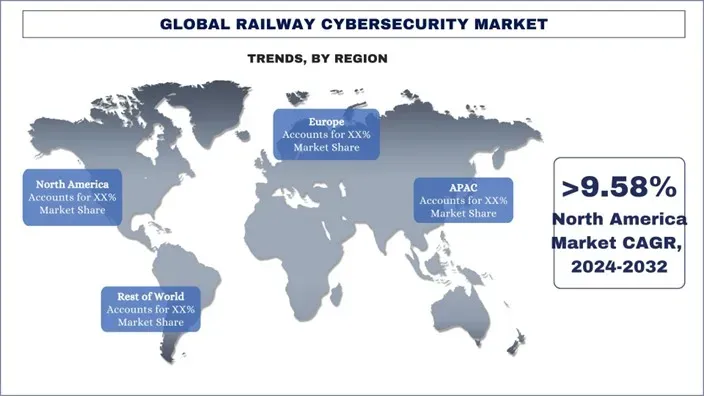
全球铁路网络安全市场规模与预测
由于全球铁路行业对网络安全的需求不断增长,全球铁路网络安全市场在 2023 年的估值为 74.2 亿美元,预计在预测期内(2024-2032 年)将以 8.62% 左右的强劲复合年增长率增长。
全球铁路网络安全市场分析
铁路网络安全是指保护铁路基础设施、铁路网络和系统免受外部未经授权的数字威胁。全球铁路一直在大力投资于数字化,用于信号、维护和各种类型的旅客服务。这些服务不仅包括互联网服务,还包括票务服务、预订服务等金融服务,其中包含客户的个人和财务数据,这些数据非常敏感。考虑到这些数据的盗窃,全球铁路都在寻求采取强有力的网络安全措施,以减少发生任何意外的可能性。
全球铁路网络安全市场在 2023 年的估值为 74.2 亿美元,预计在预测期内(2024-2032 年)将以 8.62% 左右的强劲复合年增长率增长。 随着铁路技术的数字化,全球许多铁路公司都在努力建立针对网络威胁的安全机制。铁路网络安全的一些主要目标包括保护敏感数据、确保铁路服务和系统的完整性和可用性,以及降低网络威胁带来的风险。考虑到这些挑战,许多网络安全提供商与政府机构合作,为确保铁路网络安全以及简化铁路升级需求中的网络安全机制的建立铺平了道路。例如,2024 年,欧盟宣布了《欧洲网络弹性法案》,其中描述了欧洲数字技术的网络安全要求。这些解决方案还包括铁路等移动解决方案。
对火车能源供应或网络连接的任何中断都可能对运输产生连锁反应。铁路部门是网络犯罪分子的有利可图的目标,他们可以通过窃取敏感信息或破坏运营以获取经济利益。
政府在确保铁路系统安全方面发挥着至关重要的作用,他们通过实施法规和政策,要求铁路公司采取强有力的网络安全措施,进行审计和检查以监控合规情况,并投资于研发以提高铁路系统对网络威胁的抵御能力。总的来说,有效的政府行动对于保障铁路基础设施以及确保公民和货物的可靠和安全流动至关重要。

全球铁路网络安全市场趋势
本节讨论了影响全球铁路网络安全市场各个细分市场的主要市场趋势,这些趋势由我们的研究专家团队确定。
政府加大对加强网络安全措施的支持力度
铁路网络安全已成为政府和铁路部门关注的关键问题之一。由于铁路网络、基础设施和系统会产生大量数据,包括客户和铁路员工的个人和财务信息,因此存在数据被黑客/网络钓鱼的风险不断增加。这些网络威胁可能是多种多样的,需要专门的努力来阻止铁路数据丢失的任何可能性。因此,全球各国政府都在努力将网络安全服务整合到铁路中。例如,2022 年,印度政府宣布了一项针对铁路 IT 安全策略的国家网络安全战略。其中包括针对铁路网络安全措施的强制性意识计划,以及阻止任何安全威胁的机制。
在另一个例子中,2022 年 3 月,美国政府实施了《2022 年关键基础设施网络事件报告法案》。该法案针对包括铁路在内的各个行业,在这些行业中,网络犯罪的影响可能导致严重的公共卫生和安全以及经济稳定。
考虑到全球各国政府日益关注,预计未来几年(即 2024-2032 年)铁路网络安全措施的整合和实施将进一步增加。
随着铁路行业对预测性安全系统需求的增长,预计此类铁路网络安全的需求将迅速增长,从而在未来几年改善其市场。
铁路网络安全行业细分
本节分析了全球铁路网络安全市场报告各细分市场的主要趋势,并对 2024-2032 年的全球、区域和国家层面进行了预测。
解决方案细分市场主导铁路网络安全市场。
根据产品,全球铁路网络安全市场分为解决方案和服务。由于铁路对基于硬件和软件的解决方案的需求不断增长,这些解决方案占据了主要市场份额。这些解决方案需要基础设施升级以及持续投资,这导致解决方案细分市场的支出增加,从而进一步提高了其份额。这些服务包括风险和合规管理、加密、防火墙、防病毒/反恶意软件、入侵检测系统/预防系统等。需要安装防火墙、路由器、安全通信模块等硬件系统,以保护铁路网络、端点和关键基础设施;预计解决方案细分市场将在 2024-2032 年期间保持相当大的市场份额。
网络安全细分市场主导铁路网络安全市场。
根据安全类型,全球铁路网络安全市场已细分为应用程序安全、网络安全、数据保护、端点安全、系统和管理。其中,网络安全占据了主要市场份额,因为它在防止未经授权的访问、保护通信渠道、检测和响应入侵、确保可用性和可靠性以及遵守欧洲铁路交通管理 (ERTM) 和积极列车控制 (PTC) 等网络安全法规方面占主导地位。
预计亚太地区在预测期内将占据主要市场份额
亚太地区的铁路网络安全市场占据全球主要市场份额。推动增长的一些关键因素是亚太地区拥有广阔的铁路线路和基础设施。该地区主要国家(如中国、印度、日本、韩国等)不断扩大的铁路基础设施也导致需要将老旧的铁路技术数字化,以改善客户体验。该地区最近完成了许多高速铁路项目,这进一步促进了铁路网络安全解决方案和服务的兴起。 例如,2023 年,中国铁路开通了津兴铁路 101 公里铁路,连接天津和北京机场,设有 4 个车站。该线路的最高时速为 250 公里/小时,有 8 趟列车在该线路上运行。
考虑到亚太地区广阔的铁路基础设施,以及进一步电气化和升级现有网络的需求,预计该地区将在未来几年(即 2024-2032 年)主导全球铁路网络安全市场。
中国主导亚太地区铁路网络安全市场
中国对铁路网络安全的需求不断增长,这得益于其广泛的高速铁路网络和不断扩大的铁路数字化计划。智能铁路系统以及物联网集成和人工智能驱动的自动化需要网络安全保护关键基础设施免受网络威胁。中国国家铁路集团公司是严格的网络安全规则的实施者,同时投资于该国最先进的安全技术。中国领先的科技公司华为与中国铁路通信信号股份有限公司 (CRSC) 共同打造强大的网络安全工具,将人工智能检测系统和受保护的通信框架相结合。“一带一路”铁路互联互通的扩张将引发对全面网络安全措施的需求不断增加,这将确保铁路系统保持弹性和安全。

全球铁路网络安全行业概览
全球铁路网络安全市场竞争激烈且分散,存在多家全球和国际市场参与者。主要参与者正在采取不同的增长战略来增强其市场影响力,例如合作伙伴关系、协议、合作、新产品发布、地域扩张以及并购。市场中的一些主要参与者包括阿尔斯通;BAE 系统公司;Cervello (Kearney);思科系统公司;Cylus Ltd.;通用 Vernova;日立有限公司;华为技术有限公司;泰雷兹;诺基亚
全球铁路网络安全市场新闻
例如,2023 年,印度铁路公司宣布将更新其电气列车上的 SCADA 安全。此前,一家印度网络安全机构报告了印度铁路系统的漏洞。
2024 年,印度政府批准了六个价值 15 亿美元的多轨道项目,用于运输粮食、食品、化肥、煤炭、水泥、钢铁、粉煤灰、熟料、石灰石、POL 和集装箱等商品。
全球铁路网络安全市场报告覆盖范围
详情 | |
基准年 | 2023 |
预测期 | 2024-2032 |
增长势头 | 以 8.62% 的复合年增长率加速增长 |
2023 年市场规模 | 74.2 亿美元 |
区域分析 | 北美、欧洲、亚太地区、世界其他地区 |
主要国家 | 美国、加拿大、英国、法国、德国、意大利、西班牙、中国、日本、印度 |
公司简介 | 阿尔斯通;BAE 系统公司;Cervello (Kearney);思科系统公司;Cylus Ltd.;通用 Vernova;日立有限公司;华为技术有限公司;泰雷兹;诺基亚。 |
报告范围 | 市场趋势、驱动因素和制约因素;收入估算和预测;细分分析;需求和供应侧分析;竞争格局;公司简介 |
涵盖的细分市场 | 按产品、按安全类型、按铁路类型、按地区/国家 |
购买全球铁路网络安全市场报告的理由:
该研究包括由经过验证的主要行业专家验证的市场规模和预测分析。
该报告提供对整体行业绩效的快速回顾。
该报告涵盖对主要行业同行进行的深入分析,主要侧重于主要业务财务、产品组合、扩张策略和最新发展。
详细研究行业中存在的驱动因素、制约因素、主要趋势和机遇。
该研究全面涵盖了跨不同细分市场的市场。
深入分析行业区域层面的情况。
自定义选项:
全球铁路网络安全市场可以根据需求或任何其他细分市场进一步定制。此外,UnivDatos 了解到您可能有自己的业务需求;因此,请随时与我们联系以获取完全适合您要求的报告。
目录
全球铁路网络安全市场分析 (2024-2032) 的研究方法
我们分析了历史市场,估算了当前市场,并预测了全球铁路网络安全市场的未来市场,以评估其在全球主要地区的应用。我们进行了详尽的二级研究,以收集历史市场数据并估算当前市场规模。为了验证这些见解,我们仔细审查了大量发现和假设。此外,我们还与铁路网络安全价值链中的行业专家进行了深入的一级访谈。在通过这些访谈验证市场数据后,我们使用了自上而下和自下而上的方法来预测整体市场规模。然后,我们采用市场细分和数据三角测量方法来估算和分析行业细分市场和子细分市场的市场规模。
市场工程
我们采用数据三角测量技术来最终确定整体市场估算,并得出全球铁路网络安全市场每个细分市场和子细分市场的精确统计数据。通过分析各种参数和趋势,包括产品、安全类型、铁路类型以及全球铁路网络安全市场内的区域,我们将数据分成几个细分市场和子细分市场。
全球铁路网络安全市场研究的主要目标
该研究识别了全球铁路网络安全市场的当前和未来趋势,为投资者提供战略见解。它突出了区域市场吸引力,使行业参与者能够进入未开发的市场并获得先发优势。研究的其他定量目标包括:
市场规模分析: 从价值(美元)方面评估全球铁路网络安全市场及其细分市场的当前和预测市场规模。
铁路网络安全市场细分: 研究中的细分市场包括产品、安全类型、铁路类型和区域。
监管框架 & 价值链分析: 考察铁路网络安全行业的监管框架、价值链、客户行为和竞争格局。
区域分析: 对亚太地区、欧洲、北美和世界其他地区等关键区域进行详细的区域分析。
公司概况 & 增长策略: 铁路网络安全市场的公司概况以及市场参与者为维持快速增长的市场而采取的增长策略。
常见问题 常见问题
Q1:全球铁路网络安全市场的当前市场规模和增长潜力是多少?
2023年全球铁路网络安全市场价值为74.2亿美元,预计从2024年到2032年将以8.62%的复合年增长率增长。数字化铁路基础设施采用率的提高、网络威胁的增加以及政府为加强网络安全而采取的举措是主要的增长动力。
Q2:全球铁路网络安全市场增长的驱动因素有哪些?
铁路网络安全市场正在扩张,原因是:
- 政府法规和投资:世界各国政府正在对铁路网络实施更严格的网络安全政策。
- 网络威胁日益增加:针对铁路基础设施的网络攻击日益增多,推动了对强大安全解决方案的需求。
- 数字化转型:向智能铁路、物联网集成和基于云的系统转变需要先进的网络安全措施。
- 人工智能和机器学习的进步:人工智能驱动的安全解决方案能够实现实时威胁检测和响应。
Q3:按产品划分,哪个细分市场在全球铁路网络安全市场中占据最大的份额?
解决方案领域在全球铁路网络安全市场中占据主导地位,因为铁路运营商越来越多地投资于防火墙、加密、人工智能驱动的安全解决方案和网络监控工具,以保护关键基础设施。
Q4:铁路网络安全市场中正在涌现哪些新兴技术和趋势?
铁路中由人工智能驱动的网络安全是一大趋势,人工智能和机器学习正在改变威胁检测和响应。人工智能能够实现实时监控、预测性安全和自动化事件处理,从而降低铁路网络中的网络风险。随着数字化铁路基础设施的扩展,人工智能驱动的解决方案可提高安全性,最大限度地减少中断,并保护关键数据免受不断演变的网络威胁。
Q5:哪个地区将在全球铁路网络安全市场占据主导地位?
预计在预测期内,亚太地区将主导市场。
Q6. 全球铁路网络安全市场面临的最大挑战是什么?
保障铁路网络安全的主要挑战包括:
- 遗留系统漏洞:许多铁路系统运行在过时的基础设施上,缺乏内置的网络安全,使得与现代安全解决方案的集成变得复杂且昂贵。
- 网络攻击风险:越来越多的勒索软件、网络钓鱼和恶意软件攻击瞄准铁路控制系统和运营网络。
- 数据保护和隐私问题:随着物联网的日益普及,确保安全的数据传输和存储是一个主要问题。
- 高实施成本:升级安全框架同时保持无缝的铁路运营需要大量的投资。
Q7. 全球铁路网络安全市场的主要参与者有哪些?
- 阿尔斯通
- 英国宇航系统公司
- Cervello (科尔尼)
- 思科系统公司
- Cylus Ltd.
- 通用电气 Vernova
- 日立有限公司
- 华为技术有限公司
- 泰雷兹
- 诺基亚
Q8:铁路网络安全方面的最新技术进展有哪些?它们如何提高运营安全性和效率?
变革铁路网络安全的前沿技术包括:
人工智能驱动的威胁检测:利用机器学习进行实时监控和主动威胁缓解。
区块链数据安全:确保在铁路网络中进行防篡改的数据共享。
下一代防火墙:先进的入侵防御系统保护关键铁路运营。
基于云的网络安全解决方案:为铁路网络提供可扩展的安全框架。
Q9:全球铁路网络安全市场是如何演变的?它为行业利益相关者带来了哪些投资机会?
由于数字化转型、网络威胁日益增加以及政府支持的网络安全计划,市场正在不断发展。
主要投资机会包括:
入侵检测与防御系统 (IDPS):用于实时监控和阻止网络威胁。
网络加密解决方案:用于保护铁路通信和数据。
人工智能驱动的网络安全工具:用于自动威胁检测和响应。物联网和云安全解决方案:随着铁路运营商采用互联技术。
相关 报告
购买此商品的客户也购买了










